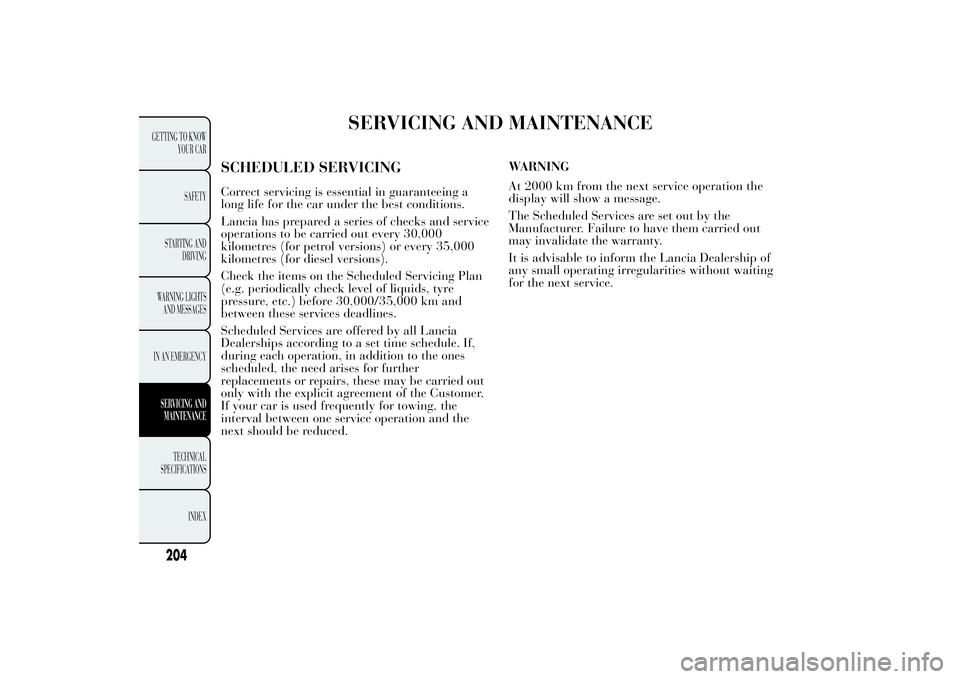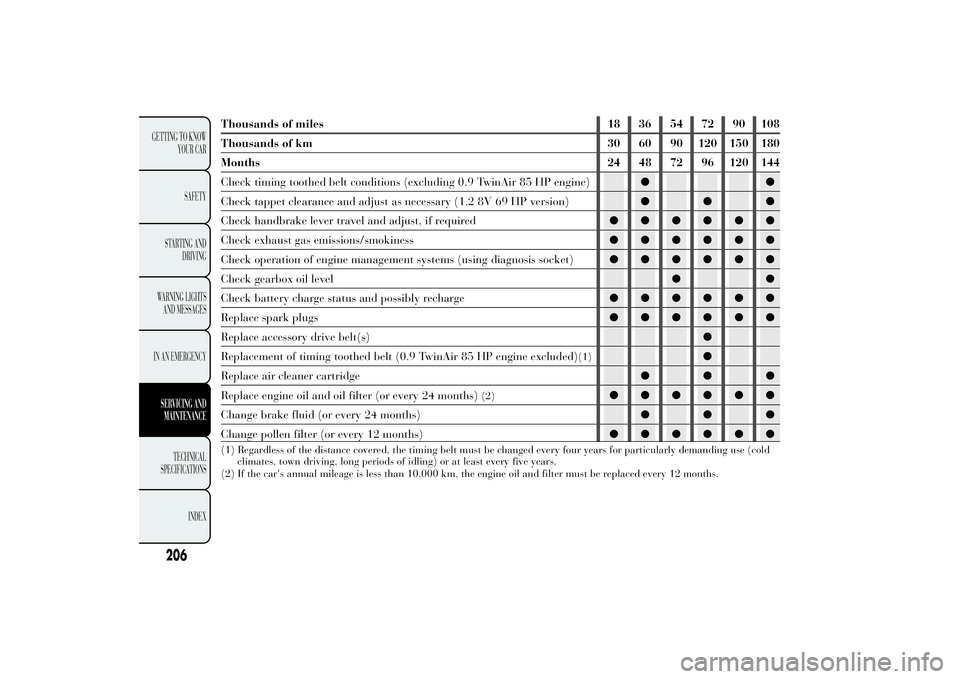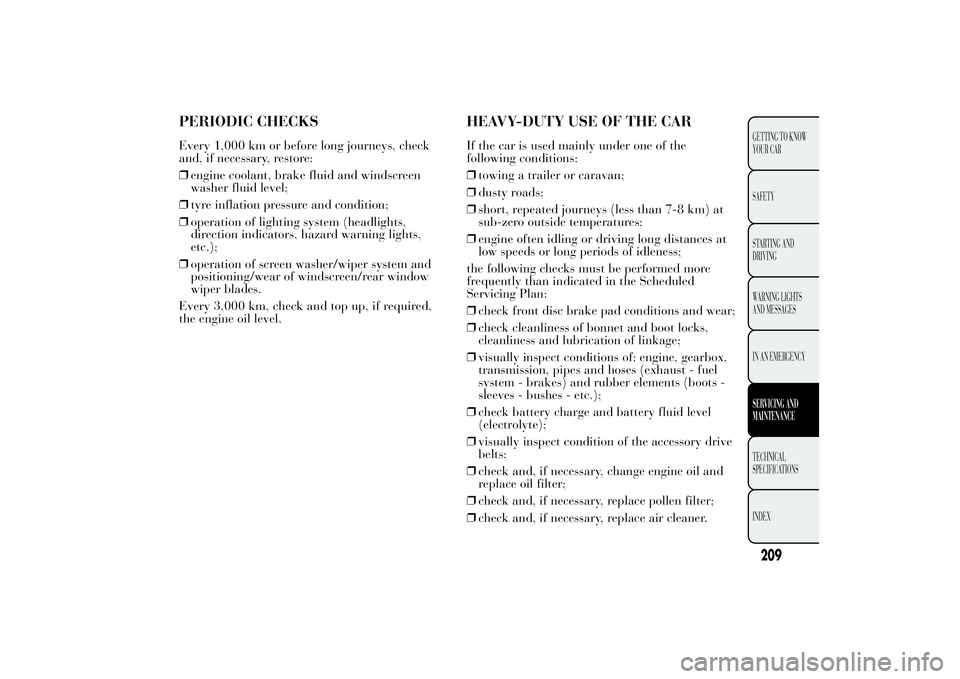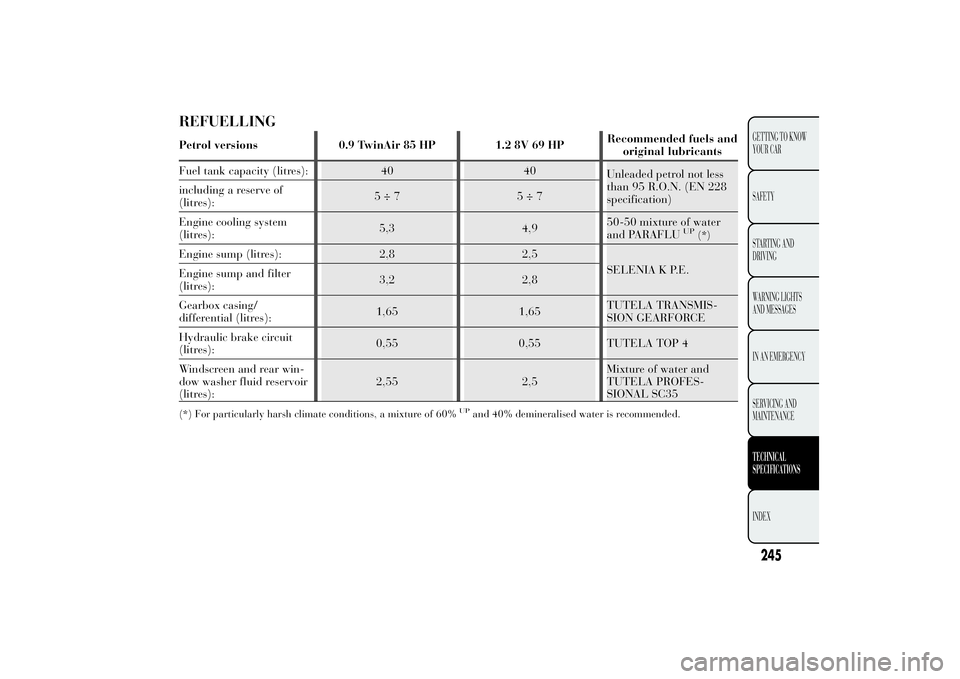air condition Lancia Ypsilon 2012 Owner handbook (in English)
[x] Cancel search | Manufacturer: LANCIA, Model Year: 2012, Model line: Ypsilon, Model: Lancia Ypsilon 2012Pages: 307, PDF Size: 13.3 MB
Page 206 of 307

SERVICING AND MAINTENANCE
SCHEDULED SERVICINGCorrect servicing is essential in guaranteeing a
long life for the car under the best conditions.
Lancia has prepared a series of checks and service
operations to be carried out every 30,000
kilometres (for petrol versions) or every 35,000
kilometres (for diesel versions).
Check the items on the Scheduled Servicing Plan
(e.g. periodically check level of liquids, tyre
pressure, etc.) before 30,000/35,000 km and
between these services deadlines.
Scheduled Services are offered by all Lancia
Dealerships according to a set time schedule. If,
during each operation, in addition to the ones
scheduled, the need arises for further
replacements or repairs, these may be carried out
only with the explicit agreement of the Customer.
If your car is used frequently for towing, the
interval between one service operation and the
next should be reduced.WARNING
At 2000 km from the next service operation the
display will show a message.
The Scheduled Services are set out by the
Manufacturer. Failure to have them carried out
may invalidate the warranty.
It is advisable to inform the Lancia Dealership of
any small operating irregularities without waiting
for the next service.
204
GETTING TO KNOW
YOUR CAR
SAFETY
STARTING AND
DRIVING
WARNING LIGHTS
AND MESSAGES
IN AN EMERGENCYSERVICING AND
MAINTENANCE
TECHNICAL
SPECIFICATIONS
INDEX
Page 208 of 307

Thousands of miles 18 36 54 72 90 108
Thousands of km 30 60 90 120 150 180
Months 24 48 72 96 120 144
Check timing toothed belt conditions (excluding 0.9 TwinAir 85 HP engine)●●
Check tappet clearance and adjust as necessary (1.2 8V 69 HP version)●●●
Check handbrake lever travel and adjust, if required●●●●●●
Check exhaust gas emissions/smokiness●●●●●●
Check operation of engine management systems (using diagnosis socket)●●●●●●
Check gearbox oil level●●
Check battery charge status and possibly recharge●●●●●●
Replace spark plugs●●●●●●
Replace accessory drive belt(s)●
Replacement of timing toothed belt (0.9 TwinAir 85 HP engine excluded)
(1)
●
Replace air cleaner cartridge●●●
Replace engine oil and oil filter (or every 24 months)
(2)
●●●●●●
Change brake fluid (or every 24 months)●●●
Change pollen filter (or every 12 months)●●●●●●
(1) Regardless of the distance covered, the timing belt must be changed every four years for particularly demanding use (cold
climates, town driving, long periods of idling) or at least every five years.
(2) If the car's annual mileage is less than 10,000 km, the engine oil and filter must be replaced every 12 months.
206
GETTING TO KNOW
YOUR CAR
SAFETY
STARTING AND
DRIVING
WARNING LIGHTS
AND MESSAGES
IN AN EMERGENCYSERVICING AND
MAINTENANCE
TECHNICAL
SPECIFICATIONS
INDEX
Page 210 of 307

Thousands of miles 21 42 63 84 105
Thousands of km 35 70 105 140 175
Months 24 48 72 96 120
Check operation of engine management systems (using diagnosis socket)●●●●●
Check gearbox oil level●●●●●
Check battery charge status and possibly recharge●●●●●
Replace fuel filter cartridge●●
Replace accessory drive belt(s)●
Replace air cleaner cartridge●●●●●
Replace engine oil and oil filter (or every 24 months)
(1) (2)
Change brake fluid (or every 24 months)●●
Change pollen filter (or every 12 months)●●●●●(1) If the car is used mainly for town driving, the engine oil and filter should be changed every 12 months.
(2)The actual oil and oil filter replacement interval depends on the car usage conditions and is indicated by a warning light or
message on the instrument panel, or in any case every 24 months.
208
GETTING TO KNOW
YOUR CAR
SAFETY
STARTING AND
DRIVING
WARNING LIGHTS
AND MESSAGES
IN AN EMERGENCYSERVICING AND
MAINTENANCE
TECHNICAL
SPECIFICATIONS
INDEX
Page 211 of 307

PERIODIC CHECKSEvery 1,000 km or before long journeys, check
and, if necessary, restore:
❒engine coolant, brake fluid and windscreen
washer fluid level;
❒tyre inflation pressure and condition;
❒operation of lighting system (headlights,
direction indicators, hazard warning lights,
etc.);
❒operation of screen washer/wiper system and
positioning/wear of windscreen/rear window
wiper blades.
Every 3,000 km, check and top up, if required,
the engine oil level.
HEAVY-DUTY USE OF THE CARIf the car is used mainly under one of the
following conditions:
❒towing a trailer or caravan;
❒dusty roads;
❒short, repeated journeys (less than 7-8 km) at
sub-zero outside temperatures;
❒engine often idling or driving long distances at
low speeds or long periods of idleness;
the following checks must be performed more
frequently than indicated in the Scheduled
Servicing Plan:
❒check front disc brake pad conditions and wear;
❒check cleanliness of bonnet and boot locks,
cleanliness and lubrication of linkage;
❒visually inspect conditions of: engine, gearbox,
transmission, pipes and hoses (exhaust - fuel
system - brakes) and rubber elements (boots -
sleeves - bushes - etc.);
❒check battery charge and battery fluid level
(electrolyte);
❒visually inspect condition of the accessory drive
belts;
❒check and, if necessary, change engine oil and
replace oil filter;
❒check and, if necessary, replace pollen filter;
❒check and, if necessary, replace air cleaner.
209GETTING TO KNOW
YOUR CAR
SAFETY
STARTING AND
DRIVING
WARNING LIGHTS
AND MESSAGES
IN AN EMERGENCYSERVICING AND
MAINTENANCETECHNICAL
SPECIFICATIONS
INDEX
Page 226 of 307

BODY AND UNDERBODY WARRANTY
Your car is covered by warranty against
perforation due to corrosion of any original
element of the structure or body.
For the general terms of this warranty, refer to
your Warranty Booklet.
PRESERVING THE BODYWORK
Paint
Touch up abrasions and scratches immediately to
prevent the formation of rust.
Maintenance of paintwork consists of washing the
car: the frequency depends on the conditions
and environment where the car is used. For
example, in highly polluted areas, or if the roads
are spread with salt, it is advisable to wash the car
more frequently.
To correctly wash the car, proceed as follows:
❒remove the aerial from the roof to prevent
damage to it if the car is washed in an
automatic system;
❒if high pressure jets or cleaners are used to wash
the car, keep a distance of at least 40 cm from
the bodywork to avoid damage or alteration.
It should be remembered that the build up
of water can damage the car over a period of
time;
❒wash the body using a low pressure jet of water;❒wipe the bodywork using a sponge with a
slightly soapy solution, frequently rinsing the
sponge;
❒rinse well with water and dry with a jet of air or
a chamois leather.
Dry the less visible parts (e.g. door frames,
bonnet, headlight frames etc.) with special care, as
water may stagnate more easily in these areas.
The car should not be taken to a closed area
immediately, but left outside so that residual water
can evaporate.
Do not wash the car after it has been left in the
sun or with the bonnet hot: this may alter the
shine of the paintwork.
Exterior plastic parts must be cleaned in the same
way as the rest of the car.
Avoid parking under trees as much as possible; the
resin from trees dulls the paintwork and increases
the possibility of corrosion.
224
GETTING TO KNOW
YOUR CAR
SAFETY
STARTING AND
DRIVING
WARNING LIGHTS
AND MESSAGES
IN AN EMERGENCYSERVICING AND
MAINTENANCE
TECHNICAL
SPECIFICATIONS
INDEX
Page 247 of 307

REFUELLINGPetrol versions 0.9 TwinAir 85 HP 1.2 8V 69 HPRecommended fuels and
original lubricants
Fuel tank capacity (litres): 40 40
Unleaded petrol not less
than 95 R.O.N. (EN 228
specification) including a reserve of
(litres):5÷7 5÷7
Engine cooling system
(litres):5,3 4,950-50 mixture of water
and PARAFLU
UP
(*)
Engine sump (litres): 2,8 2,5
SELENIA K P.E.
Engine sump and filter
(litres):3,2 2,8
Gearbox casing/
differential (litres):1,65 1,65TUTELA TRANSMIS-
SION GEARFORCE
Hydraulic brake circuit
(litres):0,55 0,55 TUTELA TOP 4
Windscreen and rear win-
dow washer fluid reservoir
(litres):2,55 2,5Mixture of water and
TUTELA PROFES-
SIONAL SC35(*) For particularly harsh climate conditions, a mixture of 60%
UP
and 40% demineralised water is recommended.
245GETTING TO KNOW
YOUR CAR
SAFETY
STARTING AND
DRIVING
WARNING LIGHTS
AND MESSAGES
IN AN EMERGENCY
SERVICING AND
MAINTENANCETECHNICAL
SPECIFICATIONSINDEX
Page 252 of 307

FUEL CONSUMPTIONThe fuel consumption figures given in the table below are determined on the basis of the type-approval
tests laid down by specific European Directives.
The following procedures are followed to measure consumption:
❒urban cycle: cold starting followed by driving that simulates urban use of the car;
❒extra-urban cycle: frequent accelerating in all gears, simulating extraurban use of the car: speed
varies between 0 and 120 km/h;
❒combined fuel consumption: calculated with a weighting of approximately 37% of the urban cycle
and 63% of the extra-urban cycle.
IMPORTANT The type of route, traffic conditions, weather conditions, driving style, general condition
of the car, trim level/equipment/accessories, use of the climate control, car load, presence of roof racks
and other situations that adversely affect the aerodynamics or wind resistance lead to different fuel
consumption figures than those measured.
FUEL CONSUMPTION ACCORDING TO THE CURRENT EUROPEAN DIRECTIVE (litres/100
km)Versions Urban Extra-urban Combined
0.9 TwinAir 85 HP5.0 3.8 4.2
1.2 8V 69 HP6.4 4.1 4.9
1.3 16V MultiJet4.7 3.2 3.8
250
GETTING TO KNOW
YOUR CAR
SAFETY
STARTING AND
DRIVING
WARNING LIGHTS
AND MESSAGES
IN AN EMERGENCY
SERVICING AND
MAINTENANCE
TECHNICAL
SPECIFICATIONS
INDEX
Page 301 of 307

Index
ABS (system) ....................... 88
ABS system .......................... 88
Airbag ................................ 137
– Deactivation of
passenger side front
airbag and side bag ........ 139
– side bag .......................... 139
– window bag .................... 140
Airbags
– front ............................... 137
Air cleaner .......................... 217
Ashtray ................................ 71
ASR system .......................... 91
ASR (system) ....................... 91
Automatic climate control .... 45
– controls............................ 45
– maintenance .................... 52Battery (charge) ................. 199
Battery................................ 217
– advice for extending
lifetime ........................... 217
– replacement.................... 217
Body versions...................... 230
Bodywork– bodywork codes.............. 230
– maintenance ................... 224
– protection from
atmospheric agents ......... 223
– warranty ........................ 224
Bonnet ................................. 84
Brake Assist system .............. 92
Brake Assist (system) ........... 92
Brakes
– brake fluid level ............. 216
– specifications .................. 233
bulb replacement......... 182-184
Bulb replacement
– external lights................. 180
– interior lights.................. 186
Car dimensions................... 242
Carrying children safely ...... 129
– Carrying children safely . 129
– child seats ...................... 136
– Setup for "Isofix" child
seat ................................ 134
Central air diffusers ............. 40
Changing a wheel ............... 169
Checking levels .... 211-212-213
Child seats (compliance
for use) ............................. 133Cigar lighter ......................... 71
CITY function ...................... 98
Cleaning and maintenance
– bodywork ....................... 223
– car interior ..................... 226
– engine compartment ....... 225
– front headlights .............. 225
– Leather parts.................. 227
– Leather seats .................. 227
– Plastic and coated parts.. 226
– seats ............................... 226
– windows ......................... 225
Climate control .................... 40
– Passenger compartment
air diffusers ..................... 41
Climatic comfort .................. 41
Clutch................................. 232
CO
2emissions..................... 251
Conditions of use ................ 150
Control panel and
instruments ........................ 6
Controls .......................... 67-78
Cruise control....................... 61
D
ashboard........................... 5
Daytime running lights
(DRL)
299GETTING TO
KNOW YOUR CAR
SAFETY
STARTING AND
DRIVING
WARNING LIGHTS
AND MESSAGES
IN AN EMERGENCY
SERVICING AND
MAINTENANCE
TECHNICAL
SPECIFICATIONSINDEX